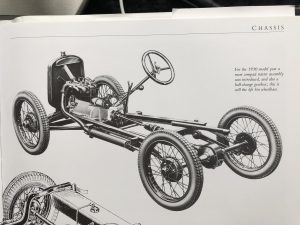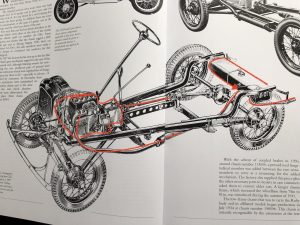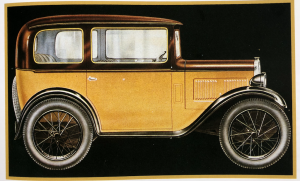This would also lean towards accommodating a matching 4 speed gearbox with synchro’ and a forward facing starter. In 1933, the norm’ probably would be a two bearing crank engine and a three speed crash-gate gearbox with a starter mounted into the cab’
The current state of the 750cc, 7hp engine is “healthy” having been checked out by my friends before purchase. However with a “clutch problem” it will have to come out and be repaired. Rated at just 10 brake HP at 2400 rpm [I think] a 10 – 15 HP DC electric motor fitted right onto the flange of the ‘T’ rear axle would be a sound option.
 So, assuming the said electric motor can be accommodated and fitted right onto the flange replacing the prop shaft, this leaves all the power train and accessories to be removed, along with the prop’ shaft, silencer, petrol tank, radiator, old battery and old electrics.
So, assuming the said electric motor can be accommodated and fitted right onto the flange replacing the prop shaft, this leaves all the power train and accessories to be removed, along with the prop’ shaft, silencer, petrol tank, radiator, old battery and old electrics.
Remember – I am NOT destroying any option to completely re-install all the removed original engine and drive components. However, I would like to justify the reasoning behind the idea of 100% electric drive.
- The existing 1937 Ruby engine and gearbox is not original
- The ‘spit & hope’ 2 psi oil lubrication of the A7 engine is horrible.
- The carburettor leaves a lot to be desired
- The simple dynamics of the engines power is crude technology
- Starting when cold either by crank or electric is troublesome
- Engine timing and converting to modern contactless spark is weird.
- Engine cooling is un-pumped and prone to leaks
- Despite a hot engine, no heater is fitted.
- The gearbox is just-about synchro’
- The clutch is single plate, vicious and hard for ‘girls’
- 6 volt electrics leave a lot to be desired
- 6 volt filament lamps are inefficient
- A 6 volt dynamo is part of the engine running gear
- The top speed of the car is only around 55 mph
- The 10 BHP is abysmal in the shadow of todays high-tech engines.
- The range on a full tank of 5 gallons is only around 175 miles
- The renovation costs of the existing power train could be expensive.
- Narrow 19″ tyres work well with a lower drag factor.
- The leaking sliding roof-well could accommodate solar panels***
- The small period dashboard could be exchanged for relevant meters
Electrics……….. (I’m not looking for 0 – 60 in 3 seconds!!!!!)
The advancement of modern high power magnets and DC motors is a solution looking for a problem to solve. One single compact 10 – 15 hp reversible motor on the prop shaft is almost a perfect marriage (to be researched**).
Removing the total weight of the engine, gearbox, silencer, prop’, radiator, petrol tank and 6 volt battery. Removing all that gear also leaves space for (perhaps) 2 stage batteries [Ni-MH along with Deep Cycle traction batteries????]. Only requiring 10 -15 hp offers good efficiency, reasonable range and reasonable charging. Converting to 12 volt nominal offers efficient lights, power and perhaps heating, along with SOLAR charging from panels on the roof***
The existing brakes could well be assisted by reverse power capture (in some way?) from the hard connection to the prop’s axle shaft rotation. The existing accelerator pedal can be accommodated along with the steering two levers for adjustments of various elements. NB : The steering wheel throttle, could be used as ‘Hand Controls’
Could you tell if this car was electric??
With all the running gear and ancillaries removed, surely renovating the remaining shell is easier??
If outwardly the car LOOKS original and that it could be reversed, has a monstrous crime been committed??
If the car can be charged (as most all-electric cars can) overnight and the range is around (say) 175 miles, could it not be perceived as an improvement on diminishing and becoming expensive petrol and also better for the environment. It would be quieter, easier to accommodate LED lights, easier to hide MODERN signalling, simpler to maintain – perhaps MORE valuable.
 My 1933 RP version of the world famous Austin 7 (I think) is perfect for ‘electrification’. The original 1933 engine has at some time in its life been changed for a 1937 three bearing more ‘modern’ 750cc engine – probably from a Ruby.
My 1933 RP version of the world famous Austin 7 (I think) is perfect for ‘electrification’. The original 1933 engine has at some time in its life been changed for a 1937 three bearing more ‘modern’ 750cc engine – probably from a Ruby.
Hi. Fascinating. Did you complete the conversion. I would like to do the same.
Ed Checkley
The 1933 Austin 7 is 99% completed, just waiting to install the batteries where the back seat was – which was a change of location.
Can you advise in list form what you used?
I’m very keen to do this to my chummy but I was thinking of using the gearbox. Third gear is direct so leave it engaged. But reverse would still be an option!
What batteries would you use? And how many?
Many thanks. Love the idea.
If you keep in touch, I will have a list on a new website for Vintage-EV.uk
I’m using EPC gear with Yuasa LEV40 packs and an EPC battery charger as a spare charger.
I had a specified charger made in China.
I have thought the Austin Seven is a good base for electrification.
I have build my own 1935 two seat special. I am also technical sales for a semiconductor manufacturer that manufactures, among other things battery management devices for electric vehicles.
Greta project!
The 1933 Austin 7 was a patinated dog (made up from various parts) which I bought sight unseen. I have no guilt at all for the conversion, it is the future which we have named ‘Franki’ (after Frankenstein’s monster). However, I also bought a 1933 Austin 10 – a much better donor, a true barn-find untouched for 47 years. 1/2 complete with all electrics from the ‘States
Wow, cool. I’m at 90 % complete with a restoration of a 1930 Seven and building the harness, and lamenting the 6vdc lighting, and found this. Whe Nicaragua when LiiPo or LiFEPo4 batteries are so much more efficient and powerful?. I also build electric bikes so play with them a lot. If mine wasn’t a great runner, I would seriously consider this. Many nights in the shop I have thought about how simple it would be to drop in an electric motor? Maybe the next time it drops a rod… 6 years on that rebuild.
You will have read, I have no guilt at electrfying ‘Frankie’, it was a ‘DOG’ – and I have another ‘Dog’ here as a runabout but much prefer the Austin 10’s (a fabulous 1933 is also awaiting the motor).
It great to see there’s like minded folk!
I’ve just finished a prototype Austin single seater special
Electric using 18650 lithium cells. It’s a blast! Not super speedy but brings a smile when driven.
Just started e retro fit to a 1938 Ruby…. direct to the prop with a 10kW AC motor. Can’t wait to get her finished….will become my daily drive to work!
Love to hear about the neodymium motors you mentioned as a postscript to your article in February 2021’s ATDC article. I am considering electrifying a 1937 14/6 Goodwood.